Future of Nonprofit Journalism Friday, September 20, 2013 Pew Research Center
Transcript follows below the video.
Part I: Future Prospects for Financial Sustainability
[about]
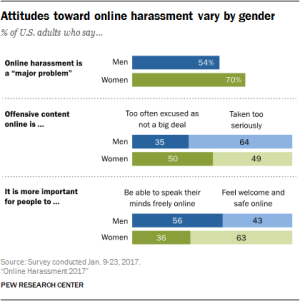
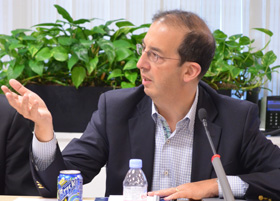
Dick Tofel, ProPublica: For us, I think the answer is yes. The Sandlers started out at probably close to 95% of the funding. Last year we had them down to 38% of the funding and this year I hope we’ll get under 30%. So that is very important diversification. I do think, as we talk about foundations as we go through this, I would distinguish – because I think it’s a fundamentally important distinction between family foundations, which I think are analytically indistinguishable from wealthy individuals who give away their money through another vehicle, and institutional foundations, which is to say people whose job it is as the Knight Foundation and many others represented in the room, to give away money that was originally somebody else’s. Those lead you to very different places.
Murray: In what sense?
[unintelligible]
Murray: Good. We should definitely come back to that, but let me go to John Thornton because Dick Tofel’s comments made me wonder if you’re prepared to support the Texas Tribune forever or you’re trying to create a sustainable model so it doesn’t have to depend on your contributions.
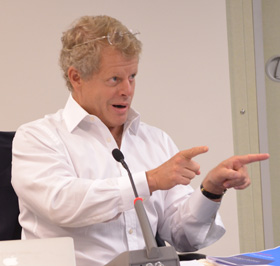
John Thornton, Texas Tribune, Austin Ventures: When Captain Sullenberger flew the jet into the Hudson, there was a line that came after in the telling of the story and at some point he said to his co-pilot, “My airplane,” and when I put my second million dollars in I said, “Evan, your airplane. So you’re it.” So the answer is, “I’m done,” but that’s, I think, great news for the Tribune – in the sense that that has been the ideal all along, is that we would, over time, diversify to the point that major philanthropy, which we define as any gift over $5,000, would be sort of gravy and would be used for new initiatives rather than to keep the lights on. We’re not there. We’re still about a third reliant on major philanthropy.
Murray: So you’re distinguishing major philanthropy from member small donors…
Thornton: $5,000 and up. The accounts don’t let us treat it that way but we think anything $5,000 and up we wish we could not run that through our income statement. We think of that as equity investment, and so we’d like to just not think about that as anything but investment in the business. We don’t think about it as sustainable revenue.
Murray: You’re comfortable with that, Emily? You’re going to get there?
Emily Ramshaw, Texas Tribune: I think the goal for us obviously is to move more toward earned revenue and it’s what we’ve been doing from the beginning. I think from an editorial standpoint – talking about foundations for a second, our goal is obviously to wean ourselves as much as we can off of major philanthropy and off of foundation money because it’s – well to put it bluntly, there are strings attached often. When you think about foundation dollars, the foundation money that we get generally comes with some kind of editorial responsibility and that’s either a responsibly for a deliverable, that’s a responsibility to build a particular data interactive, it’s a responsibility to write X number of stories on a particular subject policy vertical. So I think generally speaking, the goal for us is to move as much toward earned revenue as humanly possible because there are no strings attached.
[Laughter]
[Laughter]
Murray: You want out at some point?
[PBS documentaries]
Murray: Dan, you? Will you do 20 – 25 years?
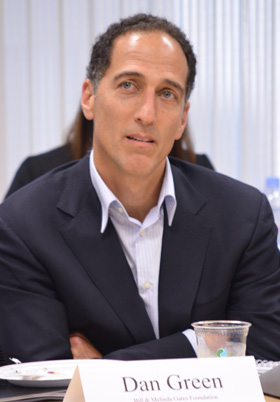
Dan Green, Bill & Melinda Gates Foundation: It’s possible. Particularly because with certain foundations like ours that have specific objectives that are well beyond journalism but are about informing, engaging even much more for knowledge building on certain issues.
[Laughter]
D. Green: Yes, there are strings. So the strings are which is why funding organizations that actually embrace the notion that they’re responsible for informing and engaging certain audiences on certain issues, those are things where if that’s the best alternative for a certain foundation with certain goals, you’ll keep doing it.
Murray: All right. Joel, how many employees do you have now?
Joel Kramer, MinnPost: I always find that a hard question because we have so many different types of part time contract/freelance, but I’d say it’s in the range of 20 – 22 full time equivalents.
Murray: Yes, and are you getting towards sustainable business model?
[crosstalk]
Murray: But you think it’s not realistic?
Kramer: No. It may not be unrealistic for the Texas Tribune…
[Male]
Kramer: What I’m saying is that the definitions matter because that is a kind of sustainability that almost resembles being in a for- profit, whereas what Dick was talking about, diversification within philanthropy, we get half our donations from people who give $1,000 or more, but we get half from smaller gifts. Well, is that philanthropy? Some people call it philanthropy, some people call it membership, but we’re not really giving a lot back. I think of it as just smaller version of philanthropy, smaller donors. So I think the question of what kind of sustainability you’re after matters. What MinnPost is after and aspires to and is making progress on, but is not there is to not be dependent on foundations for more than say, 10% or 15% of our budget but within the rest, we are agnostic as to whether we make the money from “true earned income” by nonprofit standards like advertising versus whether we get it from donors.
Murray: Do you have a goal for donations versus earning?
Kramer: Right now we get about 25% of our money from advertising and sponsorship, but we would like to get that higher, but we are comfortable with the fact that most of our money is philanthropy – most of our money comes from individuals.
Murray: Let’s hear from some of the small guys, and for purposes of this discussion, big is anybody with a double digit number of full time employees but we’ve got three people right here at the end of the table who are well below that standard. Which of you would like to talk about how it’s going? Susan?
Susan Mernit, Oakland Local: So we spend about 30% of our income from ads as well and that kind of earned income is super important to us because part of our mission is to help local small business but the place where we don’t have the resources to really do everything we’d like to is really in individual philanthropy and family foundations. So we’ve done well with national grants to support journalism projects but the kind of team – we have two people who basically are full time and a lot of freelancers, it’s been really hard too…
Murray: Two people total at Oakland…?
Mernit: Yes. A lot of freelancers and volunteers and it’s been really hard to find the resources both to build up a really competent ad team and then to really work on the board development and the kind of giving that I think some of you have really excelled at.
Murray: Based on our survey, that’s not just a problem for those small organizations, that’s a problem for the big organizations. I think the majority of people said that they didn’t have either the time or the resources to build up the business side of the business. Brian, how many employees?
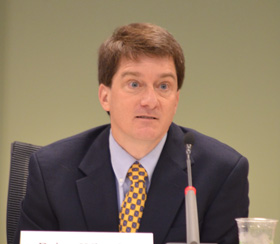
[Laughter]
Murray: Somebody here can help you with that.
Wheeler: You know, the two grants in our budget this year haven’t come through yet, so most of our support comes from individual donors. For us, the threshold is $1,000. So $1,000 up is a major donor and that’s more than 50% of our revenue. We also have underwriting on the website and that’s about 14%.
Murray: You call it underwriting, not advertising?
[Laughter]
Murray: Dylan?

Dylan Smith, LION, TucsonSentinel.com: Call it what you want – advertising, sponsorship, just as long as there’s exchange for a check on something on the website, that terminology doesn’t matter so much. We have one full time employee, essentially me, and the rest a team of freelancers just to ensure that we remain as flexible as possible as our income ebbs and flows. I certainly like to have more people dedicated full-time and just depends on the… On election night, we’ve got the biggest news team in town and other times it’s me plugging away all by myself.
Murray: So how does that work on election night? Do you have volunteers?
Smith: Volunteers and some really good freelancers and we just could go out and kick some ass.
Murray: So who wants to talk about this balance between resources devoted to content and resources devoted to developing the business, which was a consistent theme in the surveys that we did? Yes, Kevin.
[Investigative News Network]
Murray: It is what it is.
Davis: Yes.
Murray: Now some of that, in our survey – Chris, let me put you on the spot – some of that in our survey they said came from the donors, that the donors wanted most of the money to go to the mission as Kevin put it and not to overhead or…
Chris Daggett, Geraldine R. Dodge Foundation: Unfortunately, some of the statistics that people rely on for good philanthropy is the least amount of money as possible going into administration or to the organization itself. We try adage to frankly, give most of our money to general operating support because we’re trying to give people as much flexibility as possible. To me, the organizational side and what we call the technical assistance side, helping organizations develop whether it’s fund raising capability or organizational development or whatever it happens to be is as or more important than the other things that they’re doing, to be honest with you.
Murray: So how do we change that here today? That’s a consistent theme. It seems to be pretty general agreement. If someone ran the table once and argued with the notion, but pretty general agreement that all of you need to be spending a greater share of your funding on developing the business. Yes? Feather.
Feather Houstoun, Wyncote Foundation: I just want to draw a distinction here because this is a very – has a bit of a clinical feel to it. I’ve now been sort of up close and personal with about five of these and they all seem to start with people who come out of legacy journalism of one kind or another where no matter where they are, the community they’re in, and I suspect some of these are that way too – in legacy journalism, everybody had classifieds, groceries, and car dealers and so the business model was fairly simple. When you get into the kind of work that people are doing now, you’re dealing with different funder communities and donor communities, different expectations in the constituencies that you’re aiming at, but I think the thing that’s been the most striking to me across the ones we’ve seen is how hugely different the entrepreneurial impulses of the leadership is. So when you talk sort of clinically about what proportion of your business should be here versus there…
Murray: They’re doing what their passion is.
Houstoun: They’re following or they just don’t have the entrepreneurial bone in their body. It’s a big part I think of why we’re having this conversation, but without it in the DNA of the organization, they’re never going to make it. So I just think it’s a little bit more idiosyncratic to the organization. If we see an organization that is doing all the right things about figuring out how to diversify revenue, we wouldn’t be looking at what that proportion is because we can see them doing it. If they can’t produce even a plan to think about it after three or four years, you know you’ve got a problem.
[Laughter]

Ruth McCambridge, Nonprofit Quarterly: You know, I think this is interesting because I think that the categorizations of things get mixed up here. We want to talk about business, but we are in a nonprofit setting and therefore the definitions of things are a little bit different. So I think that when people look at this level of donor issue, it really has to do with independence. So in our shop, what we do is we categorize all individual donors without strings attached as payments. It’s earned revenue. Somebody’s paying because they like what we’re producing. We’re not charging anything because that doesn’t work in this environment, but we consider these to be voluntary payments. It’s earned revenue. We consider the same of any underwriting or sponsorship we have because we have to earn that by the quality of our work. What we don’t want to do is to exchange editorial, our editorial judgment for the money. That’s essentially what it is. We don’t want to exchange the focus of our content or the quality of our content for money.
Murray: How about the quantity?
McCambridge: And the quantity. We don’t want to have to do that, but I think the question is we want the quantity because we want the impact. The quantity, once we get it and we have the impact, it produces income in voluntary payments if we work it right but getting to where it works right and where people have the expectation to pay for it actually takes capital. I don’t think that we’ve gotten to the place yet in this field where we understand how much capital it takes to build up a good, strong set of individual donors and how much capital it takes to build up sponsorships, but I feel like our business model has to include – these are our strategic advantages as nonprofits. We can use volunteers as part of our structures and we can take volunteering money.
Murray: Jeff and then Margaret.
Jeff Jarvis, Tow-Knight Center for Entrepreneurial Journalism (CUNY): Quick question first to Amy. Do we have any sense of the 172 sites what their total reach is?
Amy Mitchell, Pew Research Center: Total reach in terms of audience?
Jarvis: Total reach. People. Audience.
[crosstalk]
[Male]
Jarvis: Just people. Unique.
Mitchell: In terms of unique? Well, because one – and hopefully we’ll talk about our content partnerships where the work that these organizations are doing, it’s being carried in the daily newspaper or in others that have a wider audience reach.
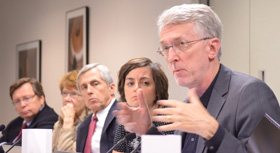
[unintelligible]
Murray: Presumably these issues are no less pressing for the ones that are organized as for-profits?
Jarvis: I get in trouble with my granola colleagues when I refused to allow my students to do not for profit but that’s because the discipline of learning the business is higher at the forefront. At the end of the day it’s a tax decision.
Murray: I do think it’s a bit of a journalist blind spot. I remember after 911 when I went to South Brunswick for the first time where all the business people and the Wall Street Journal works. Who the hell are these people? We thought we were The Wall Street Journal and there were these thousands of people making phone calls and taking orders and doing all these things but Elizabeth, you’ve got such a big buildup there, I feel like I should give you the opportunity to say something if you like and then we’ll come over to Margaret.
Elizabeth Green, Education News Network: Okay. Well, I was going to say that I actually – so we’re an organization now. We merged to nonprofit education news sites and local communities and now we have – I just calculated – we will have 12.5 full time employees by the end of the year. So I guess we’re big but I feel pretty small.
Murray: Yes. By our criteria, you’re big.
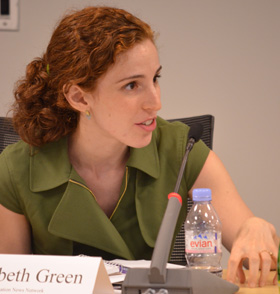
[crosstalk]
Murray: You mean what are the different ways that you can monetize your site?
E. Green: No. I mean what are the specific functions and roles? So I think we have a pretty good idea of how we should be monetizing and we’re doing it and we can invest in that going forward, but beyond just investing in earned revenue creation, there are other elements that constitute business that are important, that get that done, that I didn’t count in that column. So, marketing and distribution and engagement and operations. These are all things that, pretty much, we need to build from scratch.
Murray: Is there a model that would be applicable to the organization sitting around this table? Are you all so different that there is no model that would apply to each? Margaret, speaking of mergers, you’re merging with the local public station aren’t you …?
[with]
[crosstalk]
[into]
Murray: Eric, you’ve been making grants in this area for how long?
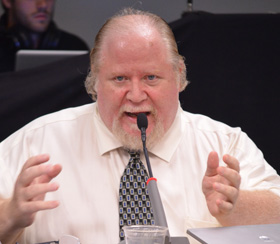
[nonprofit news outlets]
Murray: That’s one more thing you don’t have the money to spend on, right?
[Female]
Murray: And technology. Technology is another issue that maybe we’ll talk about a little bit after the break, but Steve, let me get you in here.

[Laughter]
[Male]
[Laughter]
[Male]
Murray: Penny?
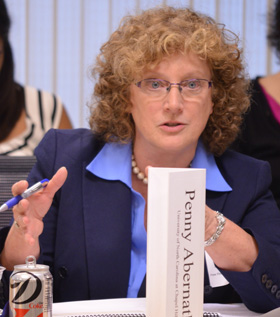
[speak]
Murray: Rose, you wanted to say something about that?
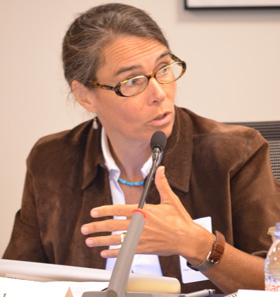
[Unintelligible]
Murray: But is there a serious scale problem here? … Maybe what you really need to be doing is go out there and look for partners, either in other locales or within your market, that you can reach the kind of scale that lets you do what you need to do to build up these business skills? …
[a]
Murray: Patch is not the answer.

Smith: Well, we’ve seen the answer to whether Patch is the answer. The bloom is off that rose.
Murray: Brian, do you agree with that?
[Local Independent Online News]
Murray: Dick, you’ve had that nametag up for a while.
[unintelligible]
Murray: That’s a good point. We’re going to go to Elspeth, Kevin, Ruth, and Joel…Then we’re going to take a break. So I urge you to be very quick and then we’re going to get some coffee and then we’re going to come back and talk about – we’ll leave the business behind because we’ve solved it and we’ll talk about engagement. Elspeth?
[with]
Murray: Good. I got the timing wrong. We have more time…I’m not going to let you take a break as quickly….
[Male]
Murray: Kevin?

[unintelligible]
Murray: Which happens to be what you’re doing?
Davis: We’re trying. So when we look at this and we say, “Which business models fit?” it really does depend on the market – we’ve said this many different ways – it does depend on the market. And frankly, sometimes a journalist – an example would be Southern Investigative Reporting Foundation – does six reports a year. And when they do their reports, their traffic spikes for about a week and it’s great stuff – in-depth stuff, business stuff – but they’re not equipped to have ongoing conversations with their communities. So they have to, by necessity, distribute their content out, and the value proposition for what they produce is very, very different than when you’re producing content in ongoing basis. So it’s very important, I think, that we don’t lose sight that not every type of nonprofit has the same market opportunity or the same commercial opportunity or the same revenue opportunity.
Murray: The result of that, how do you address that?
Davis: We have to convince more people that, frankly, I still think the philanthropy needs to be in the mix and we need to understand it. To Jeff’s point, there is an ecosystem here, and … certain content will need to be subsidized if we believe it’s important. And it is unrealistic and frankly, not necessarily – I wouldn’t say it’s disingenuous – but not every nonprofit’s going to be self-sustainable.
Murray: How many of the organizations – and I’ll come back to you, Rose – but how many of the organizations represented here in the room – just a quick show of hands – believe that the majority of the journalism you do is investigative journalism. Raise your hand. So it’s close to half, maybe a little over half. I think our survey showed of the 93 of us, twenty-something?
Mitchell: A little less than half, yes.1
Murray: Yes. Ruth?
McCambridge: I actually had a very similar thought to Kevin. One of the things that I thought was really fascinating about the Knight report is that it begins to actually set up visual patterns of revenue models for particular kinds of journalism groups. I think that is it gets to Kevin’s point, that we’re not all going to look the same. Some of us are going to be very attractive to advertisers and some of us will not be at all attractive to advertisers. Some of us are going to be great at attracting corporate sponsors and others of us won’t. So the question is, what types of organizations can attract what kind of revenue and with what kind of effort and tools? Actually, one of the things that excited me about coming to this meeting today was looking at these two reports and beginning to see these patterns of business models. That’s in fact what we need as nonprofit news sites to be able to move forward. I do think that we have some extra tools to work with, which is what I was trying to say before. We have some extra tools because we are nonprofits and we should make…
Murray: Such as?
McCambridge: Particularly, we have the ability to ask for and receive tax deductible donations and to say to people, “We’re dependent on you because we are a nonprofit. We’re not enriching ourselves through that.” That’s a very powerful tool. Secondly, that we can – we’re attractive to volunteers because we’re not enriching ourselves through volunteer activity either. So it looks like a common project for a volunteer. These two things also are somewhat connected because they are civic benefits that we get from being nonprofits. In fact, Wikipedia found – recently, they did a very, very big fundraising project – and they found that the rates of giving amongst the people who actually put their hands to the editing was much higher than the rates of giving among people who just consumed a product. That says something about engagement that I think we really need to listen to. So for us smaller people who are likely to use volunteers and maybe are not going to get as much big donor money, this is in fact an incredibly important piece of information. A realm that we need to work.
Murray: Because donors become consumers, committed consumers?
McCambridge: Well, active volunteers can become donors, and they also will attract a bunch of consumers because they themselves are networked. So it’s a business model of a type that I think we need to explore, but I think there are a number of these kinds of business models around the work that we’re doing that we haven’t quite surfaced so we can see them yet.
Murray: So we’re going to do John, then Vincent, then Rose, but before we do, we haven’t really talked about events at all. Has anybody around the table making significant revenue from events? Emily?
[at]
Murray: Yes. It’s a little bizarre because the audience is so much smaller, and yet often the dollars are bigger. Anybody else want to say anything about events before we go? Emily, did you want to get in on that?
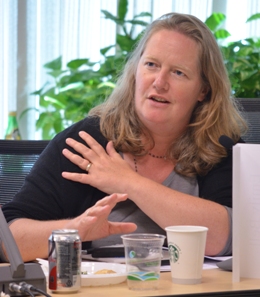
[was with the]
Murray: So you think there’s an opportunity that has not been fully tapped by the folks in this room?
Bell: You know, I really do. I think that as I say, if you were in the middle of New York City, it’s always hard to get people to come to an event but actually everywhere else, that idea that you can convene and meet as you do more shopping online, as …everything else becomes a frictionless experience.
Murray: I think Tina Brown just coined a new phrase for this sort of activity as she got booted out the door at the Daily Beast. She was going off to do ‘theatrical journalism.’ So maybe more theatrical journalism is what we need. John?
[a]
Murray: Hard for the small guys, you think? No, Rose? You don’t -? You disagree?
Hoban: Impossible.
Murray: Oh, not hard, impossible?
[Smith]
[Crosstalk]
[unintelligible]
Murray: Susan, you have something to say on that?
[of]
Murray: But no revenue?
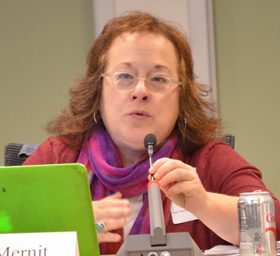
[on]
[comment]
Hoban: Well, I’m trying to do a statewide media organization. So I’m trying to build readership all over the state, so where do I do it? My state’s 450 miles in one direction. So no one place to do it. I have big readerships in two of the major markets, but I….
Murray: I’d pick the mountains or the beach.
Hoban: Yes. Exactly.
Murray: John?
[unintelligible]
Murray: So how do we do that? How do we raise the consciousness of…?
Kramer: I don’t know. I don’t know but it’s really on my mind, because in ’08-’09 there was this sort of blip of conversation about informing communities or nonprofit journalism, or whatever you want to call it, as a category of philanthropy. That sort of fizzled when people realized that newspapers weren’t just going to go away entirely, and so I don’t know the answer. But it’s damned important, and I just want to make sure everybody understands. I think bringing donors into this ecosystem is more important today, not less important, even though we’re pedaling like hell trying not to be dependent upon them
Murray: I’m going to come back to you, Joel, but I want to focus on the people we haven’t heard from yet, which is Vincent, Tom, Steve.
[of]
Murray: Yes. Tom?
[unintelligible]
Murray: Steve?
[unintelligible]
Murray: So can you put a little meat on those bones? What are some of the – because I think it would be useful particularly for the foundations here – what are some of the kind of shared services that you think could be outsourced…?
Waldman: Well, I bet others will have more specifics, but for instance, everyone’s talked about development capacity, the ability to develop membership models. That’s an actual expertise. It’s not just a matter of labor. There’s some knowledge to that. If there were people that small groups could tap into, there may be software that they could tap into. There may be technology aspects that others have probably have specific ideas.
Murray: Joel and then Amy.
Kramer: Yes. I’m going to follow up on that, but first, I want to say I think the insight that there are many different kinds of organizations in this ecosystem with many inherently different business models because they have different missions – like the difference between an investigative site that writes maybe eight stories a year and relies on other media to distribute it versus sites like MinnPost that are trying to build their own audience through volume and then sell that audience through sponsorship and advertising – and they’re radically different. One of the challenges is you bring together groups of people like this, and I know Kevin has this challenge in the variety he has in INN and I think you got this problem in this room. You bring all these people together and they are not in the same business and they don’t have the same models and they don’t have the same needs. Then, if you do have advice for certain subsets, they don’t have the resources to carry them out. So the suggestion that I would make – we haven’t really…
[Laughter]
Kramer: No, no. No, that’s not it. You haven’t asked for solutions, but one thing that could be done I believe is to divide this ecosystem into subgroups that actually have a common pattern and interest and treat them as separate groups and then have the – whether it’s the foundation world or they’re wealthy donors or whoever, I think the foundations that care about journalism could be the leaders in doing this – invest in two things: One is the centralized services that Steve is talking about but then secondly, invest enough in the organizations that they will have the capacity on their end to make use of the services they provide to us.
Murray: I’m going to go to Amy first, but let’s use Joel, your comments, and Steve, your comments, as a kind of a pivot to use the 15 minutes or so that we have before the break to talk about, “Okay, what are the solutions that can come out of this conversation we’re having here today?” Amy?
Mitchell: Yes. I think what I was going to add – well, actually lead into that conversation too, which is spinning off what Steve said, but going back to what we heard very early on in this conversation which was at least a number of the funders in the room saying they might be in it for 20 years or more, and then Eric saying, “You got to show us that you’ve got some reach impact.” But we also know from our research that the majority of these nonprofits, even if they’re all very different, have a staff of less than five. So how do you show that you’re reaching audience and how do you become able to think about actually where you could go for revenue in your community versus somebody else’s community? Which then leads to the question of whether there are some non-monetary ways that these foundations can really offer support in a long term that would have even more lasting impact or help for your organization, whether it’s consulting on business strategy or developing technology platforms or whatever the case may be that could really be something that would bring help beyond just some dollars in the bank.
[add]
[For]
Murray: Molly?

[crosstalk]
[other]
[and]
Murray: Technology is a big issue that we haven’t talked about much. I know we’ll probably talk about it some when we get to the engagement point. Our research shows one of the most fascinating things going on in the new space these days is the fact that people are actually reading more than they used to because they have these smartphones in their pocket and they walk around and can dip in on a regular basis. And yet I think the Knight study showed there were only three of the 18 that had actually developed mobile apps, and it’s a huge expense. I spent the last five/six years of my life running digital operations for The Wall Street Journal. The amount of money we were spending on technology was frightening because you’re developing for the iPhone, you’re developing for the Android, you’re developing for the tablets and that’s for the external-facing technology. There’s also the internal technology. Brian. What can we do to help you?
Wheeler: Give me some programmers. On the technology front, on my wish list is mobile applications. We’ve started building our database and geo-tagging all of our content, but the dream of developing a mobile app that will present that attractively is a reach for us. With four staff focused on getting the product out, we can’t do that kind of development on our own or even manage a team or pay for a team that could do it. Now, we jumped on the Armstrong CMS platform and we’re probably one of the smaller shops that’s using Armstrong. But this idea of having a toolkit and blending in CRM so that we can keep track of subscribers and donors in a sophisticated system – we’re thrilled with Armstrong, but I want to be able to take it to the next level, follow what the Texas Tribute is doing, but I need somebody that can come in to our shop or be available to us and make that happen. I’ve got a local technology team working with the Armstrong platform, but we don’t have time to go back and sort of figure out: Are we branching too far away in our customizations? What has Texas Tribune done that we can just grab and implement? That takes a warm body with a lot of smarts figuring out those platforms.
Murray: Did you want to say something? Did you want to add to that, Susan?
[unintelligible]
Murray: Elspeth then Elizabeth then Steve.
Revere: Yes. The comment about needing programmers really resonated with me because I’m hearing it from everybody in every field that I work in. The nonprofit sector just is not competitive for programmers. That said, I think what you just said about using technology smartly is important, and I would hope that not every group would need their own programmer, but – so that’s really kind of a challenge, I think, for my colleagues and me in the foundation world to figure out, how we can get some of these needs met. Because I do hear it everywhere I go.
Murray: Chris, did you want to-?
[unintelligible]
[unintelligible]
Daggett: Absolutely. We’ll take it anywhere, I think, in the end, because the whole idea here is to enable the entire ecosystem, not just in New Jersey, but elsewhere. Murray: Okay. Elizabeth?
[an]
Murray: Steve?
[Laughter]
Murray: So we have three very sage observers of the newspaper industry who’ve been sitting quietly for the last hour and I think we should now make them talk and then we’ll take our break. Rem, Jane, Rick, in that order.
[Unintelligible]
[Laughter]
[in]
Murray: This conversation sounds very similar to what you hear from the for-profits?
McDonnell: Yes.
Murray: I see. Absolutely. Rick. You get the final word before we go off to caffeine so make the most of it.
[see a]
Murray: How many of those organizations are represented around the table syndicate? Well, I was going to ask that question next. How many of you make money from syndication?
Edmonds: You can do it either way. You can do it and make some money or you can do it basically to extend the reach of the good work you do.
Murray: Okay. Audiences, what we’re going to come back to – we’re going to leave business behind having solved all of those issues… Edmonds: One more if I could…
Murray: Oh yes, go ahead.
Edmonds: I was interested in reading the Knight report that this particular report was not going to address quantity and quality said – or tried to measure that and that’s understandable, but I still think that’s a huge lingering issue here; is exactly how much important resources gone away from newspapers, magazines, and to some extent television? Are there ways to go from 170 organizations to – somebody said 1,500? That might be a next step.
Murray: It is. I mean, if you look at the gap, Amy, what’s the drop off over the last three decades?
[Unintelligible]
Murray: No, I’m talking about the drop off in newsroom employment.
[Unintelligible]
[those]
Part II: Innovations in Engaging the Audience
Alan Murray, Pew Research Center:

This is the good part. We’re going to talk about the journalism. We’re going to talk about how to build audiences. I don’t think any of you really got in this for the money and if you did get in for the money, you made a big, big mistake. So let’s talk about the journalism, how to engage audiences, how to grow audiences. We talked some in the last session about syndication and I know there are some people who want to talk about syndication but we’re at this interesting moment in terms of technology where you have to decide how much of your resources are going to be spent trying to go through – trying to partner up or go through traditional media outlets, how much of it would be taking advantage of the ability that digital gives you to go directly to your consumers and I think we should try and get into that and talk about it a little bit, but let’s stick with syndication first for just a minute because, Brian, I know you had something you wanted to say about it.
[alt]
Murray: Brian, those stories that are in the paper this morning, are those exclusively to the paper?
Wheeler: Yes. Well, they’re exclusive to them as a media partner. They’re on our website…
Murray: They are on your website? So you can distribute them digitally any way you want to?
Wheeler: Sure.
Murray: So it’s not holding back your digital development?
Wheeler: No. In fact, we feed directly to the newspaper’s website via RSS, all the headlines that are partner stories so the headline goes on their site automatically. The link back is to us so all the eyeballs come to our website if you’re looking at it online but we get in the print product which gets us to thousands more people than whatever come to our website.
Murray: Jeff?
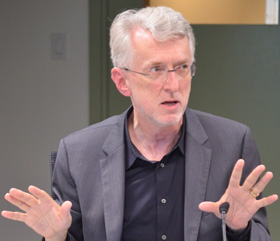
[I totally respect]
[crosstalk]
Jarvis: Funny you should ask.
Murray: …if the revenue is going to Brian?
[unintelligible]
Murray: And revenue sharing?
[unintelligible]
[Male]
Jarvis: Right now, it’s just your ad appears there. Obviously, that’s – a Baristanet post that appears in the South Jersey blog 200 miles away – that’s not such a viable ad if it’s for a hairdresser so that’s where an ad network needs to come in but it’s a first important step that you have all these big and small profit or not-for-profit media entities now sharing content, sharing audience. It’s also the basis then for doing collaborative projects and more. It’s a kumbaya moment.
Murray: Anybody else have interesting syndication content sharing arrangement? So that’s Susan?
[a public television station in San Francisco]
Murray: Rose?
[Wheeler]
[unclear]
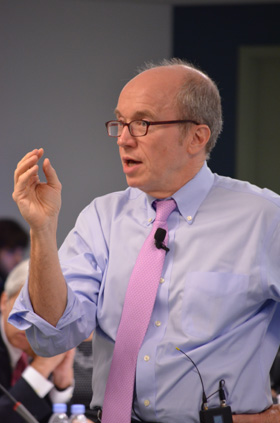
[to spot Steve]
[Investigative News Network]
Murray: Because any revenue they can squeeze out of these nonprofit/for-profits is hardly worth it.
Davis: They were spending more time trying to collect the money than they were actually getting it. I’m not suggesting that’s good. I’m just saying that a lot of people have given up on trying to monetize syndication at least on a traditional one-to-one or one-to-many type project.
Murray: Dick Tofel, how much money do you make off of syndication?
Dick Tofel, ProPublica: Not an enormous amount. I mean mostly we do use a Creative Commons license. We’re in a little bit of a different spot. The most successful thing that we syndicate in the censure – you’re probably talking about it, Alan – are our national data projects where we then encourage other people to pick them up in a way that they can localize them. So for instance, the prescribing – the prescription drug payments to physicians and then the Medicare system payments out for drugs themselves, both of those have been picked up by lots of news organizations and those applications, we have a couple of arrangements to give people a first look for which they pay but I would say that everybody I think – I certainly know we are – is trying to do two things at once, right? You’re trying to get the most exposure for and the most impact for the work you’re doing today and you’re trying to build a platform for tomorrow. I don’t see how you give up on either of those objectives.
Murray: The platform to tomorrow being direct digital…
[shrinking]
Murray: Why is that? Yes.
Tofel: Yes. The in-print part is easy. There’s no newshole. There’s just no newshole and newspaper after newspaper after newspaper has got 500-word limits. That restricts the number of partners for all of us at all times. The websites I think are simply flying at 100 miles an hour and they don’t have the staff. So here’s this perfectly good thing and they could’ve cut and pasted it. It’s not…
[Male]
Tofel: Right. Well, I mean if you don’t have the staff to cut and paste an 1800-word feature you already paid for…
Murray: But that’s just one more reason why the content sharing syndication model is eventually going to break down, right?
[Wall Street]
Murray: Joel?
[crosstalk]
Murray: Yes, please because that’s where I want to go too. I mean why…
Kramer: So just a few things about our social media work which I think people might find interesting. When we launched our site six years ago, our main way of reaching out to people and telling them what we have done was in email. We had 6,000 people who signed up to get a daily email and they would then link – in the email, we would send links to all the stories we publish the last 24 hours and much of our traffic came from people linking from that email. Six years later, we still have 6,000 people on that email even though our business has otherwise like quadrupled and what has happened instead is now most of the traffic comes from Facebook and Twitter so we get…
Murray: When you say “most,” percentage of traffic from social media?
[crosstalk]
Murray: What percentage of the total traffic is social media?
Kramer: Well, in the past month, for example, 10% of all our traffic, all our pages came from Facebook. So we now have 30,000 Twitter followers, about 10,000 likes on Facebook, and here is an interesting side effect, when we launched, the median age of our reader was 50 and now the median age of our reader is about 41 or 42.
Murray: You happy about that?
Kramer: Oh, yes
Murray: Okay.
[model]
Murray: You have something against old people?
[laughter]
Murray: How high can that go? You’re talking about 10% of your traffic now. How high do you – what’s the upside on social media, anybody? Margaret, did you want to talk about that?
[unintelligible]
Murray: Okay. We’ll come back to you. Yes, Ruth?
[full]
Murray: You’re talking about a vertical approach?
[Female]
Murray: She’s – yes.
McCambridge: Okay. I can give you an example. If we do an article on – say, we do an article on the diversity of boards in the nonprofit sector, that clearly can go out to any number of audiences that aren’t news sites. It can go out to an organization called Board Source. It can go out through an organization – it can go out through GuideStar. Those people all have huge lists that respond to them. So we don’t syndicate through another news source but we syndicate through communities of interest and that actually has done more to build our community of readers than anything else that we’ve done because that will bring in literally hundreds, thousands of people on a particular story.
Murray: There are lots of examples of that and social media reinforces that but I’m curious in this room, how many people feel or are working within a defined community of interest? It’s really a vertical approach and how many of you are working more horizontally? How many of you are verticals? I know we got – and the rest of you are trying to reach a broader audience?
[Female]
McCambridge: Yes. If I could jump in here, we started this discussion about audience really talking about syndication, about how to reach more people but I think when you begin to – there are a couple of points that are emerging that are really important when you’re thinking about this, all numbers aren’t equal. You can have a little bit of contact with a lot of people. You can have very deep contact with people that is equally important and it’s two – maybe two different kinds of outreach to build both those things and also increasingly, I think you just have to reach people where they are so the idea that they’re going to come to your website eventually to get everything, I just don’t see that happening.
Murray: So you do that through social media?
McCambridge: Through social media, through networks, through email, through in-person events, through occasional printed publications, through whatever it is that gets to the right group of people that really cares about that and we’re thinking about this challenge in two ways now. One is how do we develop deeper engagement with the people who already know us and love us and also how do we break out of that circle and have much broader impact than we currently have.
[Female]
Murray: Emily?
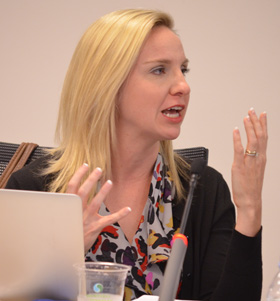
Emily Ramshaw, Texas Tribune: I want to say that I feel like when we think about expanding audience, for us, I feel like the trend really is about moving into insiders even more than we have been and we are pretty insider shop already but we’re getting ready to launch a user-generated content site that’s sort of an opinion site that’s really going to – I’m describing it as like the sexy younger sister of the Texas Tribune. We are moving into…
[Male]
Ramshaw: It works. We’re moving into the newsletter business for the people who really want to be let in on the secret, for those of you who sort of watched the Wendy Davis filibuster this summer where we had a zillion people watching our livestream. We’re getting ready to launch and kick start our campaign. That’s going to be all around buying the equipment to be able to livestream from anywhere at any time basically satellite backpacks. So I think for us to drive…
[Male]
Ramshaw: Yes, exactly. For us to drive around – when we talk about engaging your audience and who that audience is, I think for us and what I’ve heard of from a lot of you is that it’s finding those super users and really moving into that realm.
Murray: So it’s less about expanding users and more about mining the ones – I mean one of the interesting things and Mayur, you should probably speak to this but I felt one of the most interesting things about your research was how little time people were spending on these sites on average. It was two minutes.
Mayur Patel, John S. and James L. Knight Foundation: Yes, on average, between one and two minutes. Yes. I mean in general, time on site is decreasing across the board for the news industry but this was much lower. The other thing that was important to keep in mind, it wasn’t just time on site but it was also heavy bounce rates and so it was just the combination of the two that was worth flagging.
Murray: Did you want to add to that, John?
[I’ve said]
[Laughter]
[lifeline]
[crosstalk]
Thornton: I’ve noticed. Yes.
Newton: It’s just what we do.
Murray: Although it’s hopeless. That’s hopeless.
[unintelligible]
[laughter]
[Male]
[Laughter]
Dan Green, Bill & Melinda Gates Foundation: It depends. I mean it depends on obviously – it isn’t just like did we get more 19-year-olds? I mean I think part of it is and part of what we’ve been talking about doing and we’ve been partnering with the Knight Foundation on is exactly what Eric said which is at least getting – it isn’t just metrics for the sake of the foundation and the funder. Hopefully, these are metrics and this is information that the organization can use to actually better reach the audiences that they’re trying to reach and to better actually have impact on the audiences that they want to have impact on and so that’s – what we’ve realized fairly quickly is we can try to force grantees to measure but the reality is that we have to actually convince them that this is – getting this information is valuable to their own business.
Murray: I was talking to somebody the other day about this very issue and they said to me that if the metrics go to a funder, they will immediately be corrupted and that the only value of the metrics are the ones that you never show to the funder but you use internally for improving…
[Male]
Murray: I think…

[unintelligible]
Murray: Emily?
[we’ll let you know]
Murray: I’m really tempted to call on Steve here because he was talking earlier about how reporters are allergic to business. They’re also allergic to metrics and they’re also allergic to terms like audience engagement.
Bell: But they’re not allergic to feedback on their work.
Murray: No. That’s true.
[agree standards]
Murray: Steve Waldman?
[unintelligible]
[crosstalk]
Waldman: Well, I guess what I’m saying, I’m being the stodgy business guy in saying you have – your engagement discussion can’t be in a vacuum outside of the discussion of what your best business model is and there’s not a right way or a wrong way but they should be aligned. Your approach to engagement should be aligned with your approach to your business model.
Murray: Steve then Kevin.
Beatty: Yes. I don’t have a problem keeping my reporters away from their metrics. It’s more like Steve said, are they looking at the ones that matter? I don’t need my reporter saying, “Well, I got four people in New Zealand who read my story and I can see that through this.” It’s to keep them from going down that rabbit hole and figuring out, “Well, yes but how many people in New Orleans read it and had an impact and what’s the target audience for what we wrote?”
Murray: So how do you measure impact because page uses a lousy measure of impact? We know that.
Beatty: Well, unfortunately, it’s not empirical. Did that city council member wave our story in front of a city official at the next meeting and say what are you doing about this? That’s how I measure our impact is how often is our work cited, not just how often does it get picked up by our publication partners which is always nice but how often does somebody see it and do something about it? We’ve identified a problem and someone’s taken some action whether that someone is a community organization that wants results or it’s a public official that’s made something happen.
Murray: Kevin?
Davis: Yes. I mean before I got into the journalism game, I worked for movie studios and worked with them and there have always been buy side metrics, sell side metrics and internal metrics and you use them for different things. One of the things that I recently wrote in the piece in NetNewsCheck is we spend a lot of time writing grants and reports and things like that so this is a small thing but if people would start to agree on some standards, we wouldn’t have to redo them every single time. We’d write a grant request and report, right? If we consider foundations to be on the buy side, it would be a huge asset to have at least start to approximate. My second point is this which is…
Murray: To have the foundations agree on a set of…
Davis: Yes.
Murray: …measures that they want to monitor?
Davis: And allow them to be imperfect. I don’t know of a single perfect metric on any of the media on the buy side or the sell side. They’re all approximations. I mean Emily’s point was well-taken. So box office is a lousy indicator of how successful a film is so is Arbitron ratings but the fact is that it’s – there’s a reason why these markets move the way they do and that’s a real opportunity there that can really cut out a lot of inefficiency.
Murray: Joel and then Vincent.

Kramer: Yes. I want to echo that. I think on the subject of measuring what we do, obviously, the Holy Grail is real impact on people and society. I happen to personally not be interested in spending an enormous amount of time on trying to measure that in a quantitative way because I personally think it’s so difficult. The second level though is there are metrics out there – and let’s start with Google Analytics which everybody uses – but which are – and this is echoing Kevin’s point. They’re terribly misused and they’re used differently by everybody and it would be of great value if we could agree on which metrics in the world of say Google Analytics, which web metrics actually matter and why and let me just give one example, okay? Uniques which keep getting talked about in my opinion in our business – I can’t speak for others are worth zero. They have no relationship to the success of our business. The issue of bounce rate, bounce rate is high because of the number of people who come to your site who aren’t interested in your site so they are functionable as uniques. If you run a website and you run content on it, you are going to get an enormous number of visitors mainly through search and secondarily through various other kinds of linking who are not interested in your site. They will visit for 10 seconds and then after they’re gone, they won’t remember if you asked them where they were and they come from all over the world and maybe even all over the nation but if you’re a local site, they are absolutely irrelevant to your business unless you’re selling national advertising at $0.80 cost per thousand which I recommend you not do, okay? So what we need at least within that web world is some agreement for the foundations, for donors which are the measures that can count. I can tell you for us, we’re interested in people who come back more than once a month. That may not sound like a lot, twice a month, but the reason we think it’s so important is the behavior of people who come twice a month is radically different from the behavior of people who come once a month.
Murray: Do you have that metric?
[crosstalk]
Murray: Just before we leave this, what in your experience is the correlation between uniques and the number of people who come to your site once a month or the number of people who come to your site more than four times?
[unintelligible]
[laughter]
Kramer: Well, that’s the problem. That’s why you can’t use Google to measure this because they don’t – they only answer it by them operating – whatever they call it the operating system or – so what I’d say matters is people who come back more than once and also local people if you’re in the local business and then – and also time on site only among those people who come back.
Murray: Who come back?
Kramer: Yes.
Murray: Vincent?
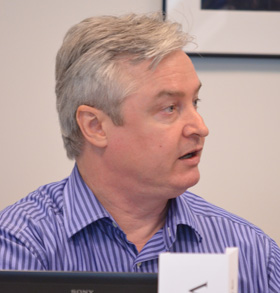
Vincent Stehle, Media Impact Funders: Journalists might be allergic to metrics but actually, you could take something for your allergies. I take – I’m allergic to my cats so I take a pill every day
[unintelligible]
Murray: Tom?
[unintelligible]
Murray: So can we go back a little bit to social media because if the goal is to get people who are repeat visitors to your site, is social media a good way to do that? Who’s having success using social media to build audience of the sort Joel’s talking about? Steve?
Waldman: Yes. In the draft Knight report, we came out closer to the top end on – we’ve got about 25% of our traffic come from Facebook and Twitter and we’re aggressive about every story that we post, sending it out on the different day parts to make sure it goes out once in the morning, afternoon, nighttime. We rotate whose duty it is to tweet out the stories on the weekend when people have a little bit more free time to read the longer stories that we do and we found our weekend traffic went up remarkably just on retweeting our stories, maybe picking up on a quote or doing something other than the headline but we’ve…
Murray: Does that build committed audience?
Waldman: I think it does.
[stories]
Waldman: I think we have a lot of repeat visitors who come for that. I will definitely seize on the idea that uniques aren’t that big a deal. I like that idea.
Murray: Elizabeth?

Elizabeth Green, Education News Network: Sorry, I was going to comment on measurement rather than social media. Is that permissible?
Murray: You’re permitted. Yes.
E. Green: Okay. So we created an internal dashboard just for reporters so not business focused impact but just for editorial impact and we created that organically out of our own desire to know what we had done in the past week, month, year but an interesting development as we’ve been building this, it’s taken us longer than we thought partially because there is a gap emerging between the goals that we were setting internally for our reporters and the goals that we were imagining that maybe funders would like to know about and then goals that are more of external and to do with sort of imaginary ideas about what impact means and so I think that’s just an interesting anecdote to throw out is that trying to fill that gap. So I think a lot of the difference has to do with adding in a look at the practices that are most likely to lead to results because the acknowledgment that – we just – we will never really be able to measure this perfectly. I think we have to start there and then say okay, well, if we can look at what are the highly likely practices that will highly likely lead to the following outputs or outcomes then those are the things that newsrooms can actually restructure themselves around and reporters can really think about much more than something very abstract like a year out if that makes sense.
Murray: Dan, did you want to say something or do you just have your…
D. Green: Yes. Well, one was as long as Emily and others have made a point about the measurement work. So one is to at least note – for those of you who don’t know that Knight and Gates have funded the Annenberg School at USC to launch the Media Impact Project with a specific goal of better defining engagement, ways of measuring engagement and better understanding when does that engagement actually lead to the kind of outcomes that funders talk about which is raising awareness off and building knowledge, measuring attitudes, perceptions and even behavior change. So really getting a better understanding of when does engagement as you define them and we had an initial meeting even that The New York Times came to and NPR and The Guardian and participant and they even already started to come up with five buckets of engagement and so hopefully, that will all – as we start talking about it, just keep an eye out for that because I think that will be helpful in the end because really, a lot of this has to do with what funders really care about as an overgeneralization is back to what even what Elspeth said is the outcomes that we’re talking about and how do we get a better understanding of how do we get to those outcomes. I mean to some extent, take Steve – Steve, your point about the business model but the business model also as it relates to what are the goals or the outcomes that you’re trying to get to and my hope is – our hope is that funders get good at articulating that. The media organization can agree that those are mutually-desired outcomes that we should figure out how to measure. The last thing I’d say is that part of the Media Impact Project work too is also building a technical assistance team that would then work with media organizations to specifically help them on their own metrics as a separate little bucket of money and support that would allow organizations to get teams of people to come in and do a look at what are the metrics that you’re currently getting depending on the outcomes. Are you taking in the right information or are you – as a point made as uniques actually make sense for what your goals are. Probably not and so trying to figure out ways of what we want to do is better support media organizations to be able to do it because it’s not helpful to say you need metrics but we all don’t help you figure out what are the right ones to get.
Murray: Dick?
Tofel: We started I thought earlier by saying that we thought that our businesses were very different from each other and I think there’s a lot of truth to that, different markets, different missions, different kinds of journalism and then somehow, we got around to what I thought was almost an emerging consensus that we wanted the foundations to tell us what the agreed upon set of metrics are. These two things do not connect, right? So I just want to spot that for people. I thought what Steve Waldman said about business models is critical. You need to know what yours is. There is not one. You need to know what yours is and then the last point is I believe – the more I think about this, the more strongly I believe that transparency is critical to this. Accountability is very difficult in the nonprofit world. When we talk about running these places as businesses – for-profit business, it’s easy. There is top-line growth at the beginning and bottom-line growth ever after and there you are. Nonprofit is much more difficult and one of the things is I think it’s difficult for us and I think transparency, if you are willing to decide what you think is important and then to tell the whole world quite publicly and on a regular schedule, how you’re doing on it, by the nature – by human nature, you will drive to that. Now, you may have the wrong direction. Maybe you’re not going to the right place then you’re going to lose but if you are going to the right place and you are posting how far and how fast you’re getting there, it’s going to help a lot.
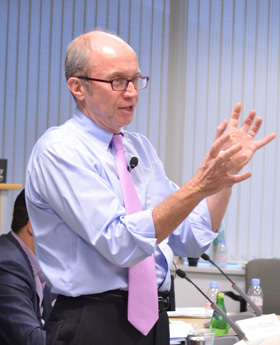
Murray: Yes. Chuck Lewis, you’ve been sitting there very quietly and taking great notes and I can see it’s sort of all coming together on the page and I think the time has come for you to share the synthesis with us.
Chuck Lewis, Investigative Reporting Workshop: It’s a pretty tall order there. Well, I have just follow off what I’ve just heard here. I do think and have recently written and we’ve talked to a few folks here, I do think that the grantees, these various organizations do need to have a sense of shared values about the so-called metrics. I do think there is a sense initially that most of the interest in this was frankly from the foundations and there is reminiscence here of what happened to other forms of commercial media with metrics over the last 10 or 20 years with story counts and headcounts and folks heading for the door. So I think INN, the Investigative News Network with – it’s an 86-member organization as an example and we’ve talked should take – there’s a couple of groups inside INN, the Wisconsin Center for Investigative Journalism that Andy runs and I think Investigate West, I think there’s been some conversations of actually finding some sort of common ground to what the journalists in the trenches think is relevant. That doesn’t mean that all the things that we’re hearing are not valuable and very extremely useful including some of the studies that are going on now. I’m not saying that we shouldn’t have those studies but I think this is a new space. Yes, let’s just be really blunt. Local scientists studied participation for half a century and it’s gotten so much better and I think there needs to be a little bit of humility here about this. I’m an old-fashioned guy. To some extent, I think it would be wonderful the more if foundations could also occasionally support the journalism.
Murray: Yes.
Lewis: The actual content. I happen to think that’s really important. We just lost 30% of our reporters in America since 2000 and it’s wonderful that we’re getting better and better with all the metrics but it would be great if – reporting takes time and it costs money. The commercial realm in many ways can’t do it anymore and in many ways was not doing that much investigative reporting even in the last 10 or 20 years as must be direct. So I think we have an issue here also qualitatively about the best reporting that’s out there and I think foundations do support other sectors and they’ve been doing it for a century and I think they’re going to continue and I think it’s necessary to continue this kind of work. I’ve watched all the accountability. I’ve been in this space 24 years and the most interest in metrics has been the last couple of years.
Murray: No. It is interesting. We did start out the session talking about great journalism and somehow we drifted into metrics which as you point was not – for most journalists, a completely foreign topic. I mean I spent decades of my career in news meetings with editors who said, “Our readers like this and our readers don’t like that and our readers want more of this and they want less of that” and the truth is they didn’t have a clue. They had nothing, didn’t have a shred of evidence what our readers liked and didn’t like. It was just a good thing to say in news meetings. It is a pretty dramatic change but it’s also a reality, right? I mean that’s what the funders are looking for and the metrics do exist so it’s hard to ignore them. Mark, we haven’t heard from you.
[Investigative Reporters and Editors]
Murray: Can you just go a little further with that? Specifically, what sorts of things are you talking about?
Horvit: Well, just one simple example is that there are different ways to do – and so we work with for-profit legacy, whatever you want to call it, media and nonprofit and everyone’s dealing with a lot of the same issues but – so the traditional method of doing an investigative project is to work, work, work, work, work, gestate, gestate, gestate, give birth to this big thing when it comes out and then go take a nap, right? So that’s fine but what you’re seeing more and more of and partly out of the same necessity is the rolling investigation kind of thing, the idea that you break this into – the work is not less important and you don’t do less – the impact isn’t different in the end but you’re breaking this into pieces as you go along and there’s a sustained constant hit. We’re talking about doing the…
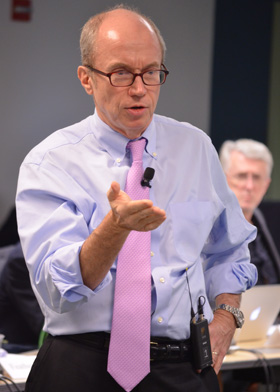
Murray: You build audience by doing that?
Horvit: Yes. Right, exactly. I mean it’s anybody – and just from forgetting about the business part of it, when we go and talk about this and we’re talking news organizations, anybody can withstand one hit if you’ve done something wrong. If there’s one big hit and it disappears, the odds of having any impact are very slim but if you beat that drum continually and if it comes out in pieces and you keep it going for a while, you see all sorts of impact happen that might not have happened otherwise but that can also play into the way you bring traffic to your site, into the way people respond to it and the kind of audience that you build. So I just think that the way you think about doing your content has to factor into this whole discussion, not simply how you get word out about it once you’ve done it.
Murray: Anybody want to respond to that – to that point in particular, the campaign, the repeated hit? Emily?
Bell: No, I mean that’s absolutely said much better than I could say but that’s why we teach in reporting classes because it is absolutely tied to the format, the way that you report something out and that is tied to the platforms and social behavior of people in the wider world. It is tied to the fact that continual partial attention is now completely different for publishers than the packaged media world where you’d send something out. You knew that you had a very predictable reception and response to it and when you look at the work that ProPublica does in this – it’s had a great story out today but just as important is the format of that and that, we were talking about earlier and saying this is about process. It’s about understanding process.
[around]
Bell: No, it’s not once and done. It’s about understanding the entire lifecycle of that and understanding how the reporter and the editing and the presentation fits into that but where that gets us too on impact metrics, I’m not quite sure. I think it gets us to a point where we – where actually it’s a professional craft. We understand just much more about what we’re trying to do, who’s reading us, how we can make them understand or read a bit more in an intelligent way rather than the way that’s necessarily dictated by different business model which is the pure advertising or subscription business model and that’s the big thing for nonprofits which is the measurement of impact is inevitably going to be different.
Murray: Brian?
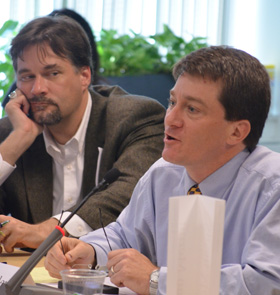
Wheeler: The metric I’m worried about right now is our fall fund drive, right? So we’re going to be doing fundraising and going back to social media, we didn’t experiment. We matched home addresses to as many of our Facebook followers as possible and we sent them a targeted annual fund drive campaign letter with an envelope and very few of those came back. So what we found was that that audience, while its 14% of the traffic driver to our site, it’s not a rich resource as far as our fund drive. So the people that send us money are those that get our weekly emails so that list is about 11,000.
Murray: Where do they come from?
Wheeler: Well, we recruit them over time, build up that list but those are people getting a weekly dose and they’re clicking through and those are our annual givers. They’re giving under $1,000 but that is a much better channel for us to try to raise money.
Murray: Margaret?
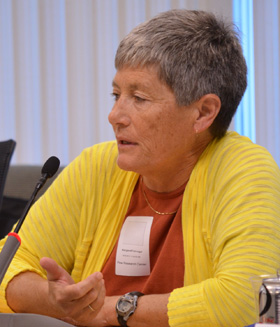
Freivogel: We tried a quick experiment a couple of weeks ago in different kinds of coverage related to a veto session of the legislature and instead of just doing the standard preview story, we broke it down in a lot of different ways, cast of characters, Veto Session 101, scorecard, live tweets, stream and some of these we thought might be more sharable in Facebook and some of them work better on Twitter and some of them work better on our website and so we’ve – then we can go back and look at who – looked at what but all in all like created a lot more involvement than simply the standard coverage.
Murray: Okay. So let me turn the conversation here just a little bit because we’re going to run out of time very quickly and this is a pretty unique opportunity to have all these people sitting in one room for even a brief period of time and I don’t know when we’re going to get you all together again. So I’d like us to walk out of here with some suggestions on what can come of this that will actually help to get us to the goal we’re talking about. I mean what are the next steps that can grow out of this discussion we’ve been having for the last couple of hours. The tags, the nametags all go down. Susan, do you have an idea? Yes?
Mernit: I find this discussion very energizing and I appreciate the chance to hear from so many groups that are so different than Oakland Local in terms of their size or their location. I think that actually putting some resources toward a smaller group that was a best practices task force, that would be fantastic because there are many people here like Brian who I’ve talked with quite a bit and some people, I never talk with and some of the ideas here like John Thornton’s equity, I would love to actually pursue that in my own area. So I think looking at maybe doing a follow-up survey, looking at what some of the greatest needs are, I mean how could you fuel some small working groups that could do some very specific toolkits just the way Knight has funded community toolkits that people actually use. Maybe some of us could help create toolkits that this field could use.
Murray: Is that a shared view? I mean in general, among the practitioners here, let’s leave the funders out for a second and the thought leaders out for a second and we’ll leave Jeff out for a second. Among the practitioners, do you have a lack of contact with each other, a lack of ability to understand best practices or do you feel like you’re getting all that you need? Steve?
[Local Independent Online News Publishers]
Murray: Anything additional you feel you need? I mean what’s your view of what should come out of this discussion today?
Waldman: Well, one very specific thing that we’ve touched on a few different places and like John, I’m also envious of Joel, is that the demographic research of our own audience. I have a chance I think with a partnership with a local university to do a little bit more audience study but I hope they have the expertise at it because I certainly don’t, but to be able to say to both funders and advertisers and just to their fellow readers, here’s what our readership looks like.
Murray: Kevin?

[Center for Public Integrity]
Murray: You’re really asking for patience?
Davis: I’m asking for patience but also let’s – for example, I think it’s exciting the grant that Texas Tribune and John Thornton is doing and some of that stuff too. We need to reward best practices but we have to also recognize that not everything fits and we have to take a look at it that way so yes.
Murray: Steve?
[zoom up]
[Laughter]
Waldman: I think Pew and Knight are – I sing Pew and Knight’s praises all the time and not only because my last two paychecks came from Pew and Knight.
[Laughter]
Waldman: That’s great but when you think about where the support – putting Gates aside for a second – where the support comes from, Carnegie, Ford, Knight, Pew and yet when you look at the winners of the new economy, Apple, Google, Verizon, AT&T, which in – just taking those four companies and again, I’ll occupy Pew on you but the amount of money that – or profit that those four made in a quarter is $24 billion. Just one quarter – not revenue but profit from those four companies and all this by way of saying that if the winners of the new economy put even a tiny bit of their wealth into this as an issue, we – this whole space would be transformed. With all of this – all of the conversation that we’ve been having about how to get more bang for the buck and how to be more effective is absolutely true. You have to do that but there’s a bigger…
Murray: It’s worth pointing out the winners of the new economy were winners of the new economy on other people’s content.
Waldman: Well, that’s – okay, once again. Putting aside whether or not anything – it doesn’t matter whether good things or bad things were done, it’s just positive that it was all good stuff but it still matters that there are huge entities that are on the sideline for the most part in this debate who have the ability to have a massive impact.
Murray: It’s an interesting point. Chris, you wanted to say something about that?
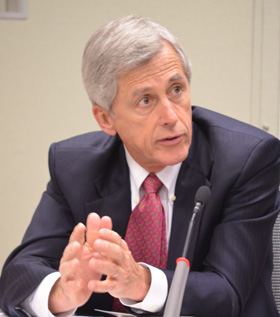
Chris Daggett, Geraldine R. Dodge Foundation: I do. So I mean speaking from a funder standpoint, in my view, a couple of things, one, we don’t say it enough. I think this is all about democracy for me and we – it’s the undercurrent here but it’s all about getting people engaged and in my mind among other things from a funder perspective picking up on what you said, Steve, we as funders that are in media now or supporting media need to help you get other funders involved and we need to do it by going to other foundations. We need to go – Knight has done an incredibly good job of doing a lot of your funding through community foundations but what hasn’t happened is the up sell. The people that are in community foundations, the donors or the people that are in donor-directed funds don’t get – we need to mine them and get them interested other than just having community foundation use some its discretionary money which unfortunately is usually just a pittance relative to the overall community foundation and we need to mine those databases, if you will, and start to really aggressively pursue them. I see that as a – if I told you how much time I spend personally in trying to build collaboratives of funders in not just media but in education, other areas that we fund, I spend an enormous amount of my time because I deeply believe that if we have an interest and you have something in your guidelines that says you’re interested too, I’m going to go talk to you because I want to understand what in that area you’re interested and can we collaborate because if we pool our money in a similar fashion you’re talking about, we can have a much greater impact. So I think that – if the thing that we’ve been starting to talk a little bit about this among funders, we’ve got to do that and we’ve got to do it sooner rather than later and we’ve got to do it – casting as wide a net as possible.
Murray: So we’re going to do Margaret, Brian, Elizabeth, Vincent, and then Michael’s going to wrap us up.
Freivogel: So what the people in this room collectively can do is articulate in a way that is visible nationally why this movement of news organizations is important. Why it’s important to the future of communities that it’s necessary for various kinds of funders to step up and support it and what’s the realistic expectation at this point for the experiments and organizations that are existing and all that done in a very visible way would be very helpful to those of us on the ground going out and talking to people.

Murray: Brian?
Wheeler: I worked at the W. Alton Jones Foundation for seven years so I have a little bit of foundation experience and I think we were known as a collaborator with other funders, Dodge Foundation, Surdna, et cetera. Now, in this business running on nonprofit, what I want from funders is somebody to say, “We want to be your partner.” I want them to come to us and say, “How can we help you innovate and take that initiative?” That would help us a lot. We don’t have the time to think about all of our needs and then put them into a proposal that would pass muster with a lot of the funders but we’re doing good work. We’re survivors. We’re persistent. I mean this group right here I’ve gotten to know really well and we’re doing amazing work in our communities but to get a nudge in the right direction to take our tools and our platforms and our training and our expertise, we could be partners with you but some of the initiative I think needs to come from the funders back down to us.
Murray: Elizabeth?
E. Green: That’s an awesome point. I just want to repeat something I said earlier which is connect us to each other but also connect us to outside resources. So that trip that I made to Birchbox, tech companies like that that have already invested in the growth edges that we’re working on, I would rather learn from them and to have all of us to do it together at the same time.
Murray: Vincent?
[is]
Murray: Michael, you get the final word.
Michael Maness, John S. and James L. Knight Foundation: I have more than one. Is that all right?
Murray: You get the final words.
[unintelligible]
[Male]
Maness: Large money, yes. That has to go through our board approval process because of the size of it but I’m just saying you know that what I’m hearing and we’ve heard that before and we’re trying to figure out a way to do that to reward that iterative experimental spirit and to help you future proof but you have to have a plan to do that. You have to have some idea of demonstrating it and showing that it is a thing One of the things you point out with the Texas Tribune all the time is that if you break down what their organization in terms of payroll looks like, it’s thirds and thirds and thirds. It’s a third business step, a third tech, a third content and that’s the kind of thing you really need to think about and what can you stop if you don’t feel like you can – the beast that you created doesn’t necessarily have to be fed every day. You can also raise another beast so if you really think about what those things are. A super big thank you to Pew for all the hard work and for Alan, amazing job. So thank you very much for hosting and being master of ceremonies. Again, we really appreciate that. You’ll have more communications from us around this process in the next 60 to 90 days but we really appreciate coming this afternoon and safe travels everyone. Thank you.
END




